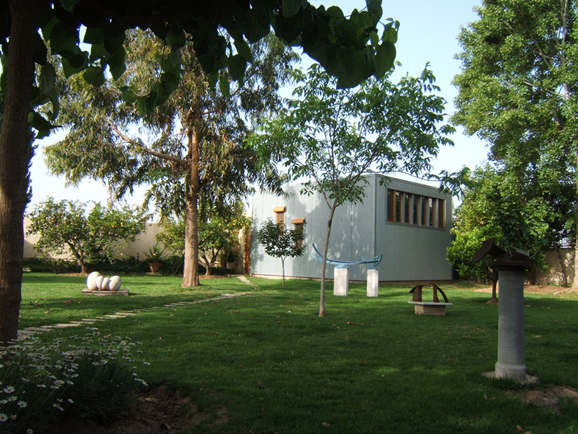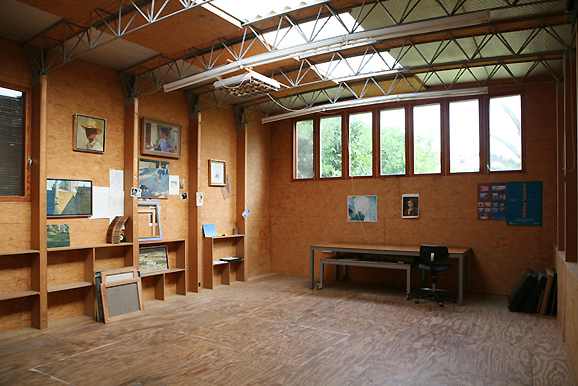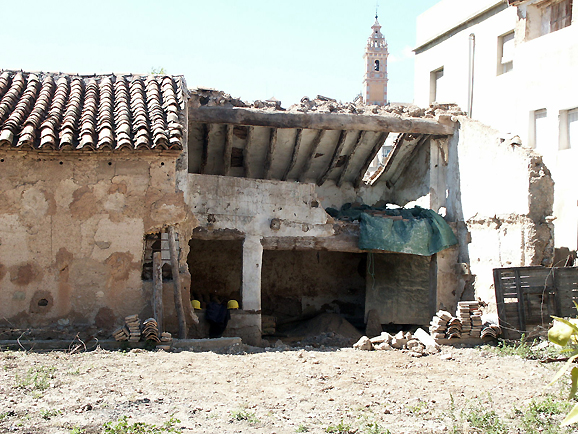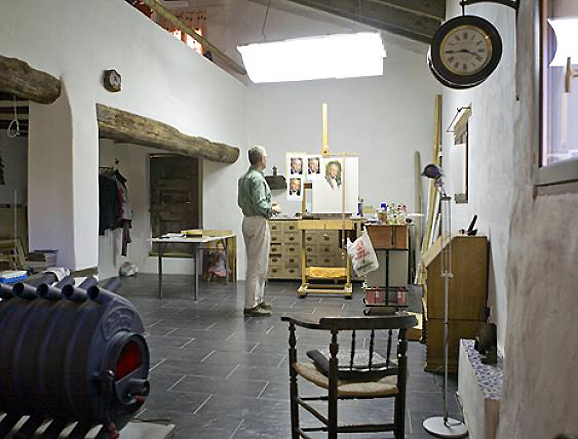I must agree that not every artist has the possibility to built his own studio, but I had.


In this picture you see my former studio in Paterna that Helma and I built ourselves in 1997. It has a daylight roof and the windows can be closed with moveable shutters. Even in winter I was able work without artificial light. It was a marvellous place to work! The design and the construction was based on information from The American Plywood Association. We designed the roof construction and made it ourselves.
I have been working in my studio in Chelva since 2010, in the house that we restored.


It would have been impossible to construct a daylight roof without spoiling the characteristic shape of this 500 year old olive mill.
Recently I began painting portrait, attending a class in my neighborhood. Very fortunately, I came across your video tutorial, fascinating not only in the painting video itself, but also your way of living, story, ingenuity and comments. I have a few questions for now. If already raised and answered, pls don’t bother. I will go over all of your comments and sites.
1. You said here ” we built ourselves”. Does this mean Helma and you worked (labor) for most part of construction? Amazing. The studio loos like a major construction.
2. In other video, I saw you use a mirror to look at your painting. I am curious what special advantage this gives.
Best Regards
Chung
Hi Sung.
The studio in Paterna we built completely ourselves. Yes it was a major construction and it was big fun building it!
About the using the mirror: If you are standing a couple of hours close to the easel, in the end you cannot judge the form, colour and values because you are not as fresh anymore as you were in the beginning of the day. Looking to your canvas in a mirror you get a fresh image and you are able to judge the whole thing better and detect errors easier.
That is why.
Best
Ben
Thank you very much!
Best Regards
Chung
Thank you very much!
Best Regards
Chung
Oh Ben I am so glad to find your website with all it`s generous tips and videos.
I am thinking now of buying your video on painting portraits to try and improve my style.
I am retired now but don`t have access to a great deal of money.Is there a less expensive
canvas that you could recommend, with perhaps some of the positive qualities of using linen ?
Perhaps you could describe what it is about linen that you enjoy in comparison to cotton.
Again thanks for all the helpful tips!
While I`m watching your videos I feel that I`m in the company of a friend.
Goodbye for now
Peter
Hi Peter.
Nice to read your comment. It all starts with good stuff. Bad canvas won´t let you paint any good art work. So linnen is the best. (But still it has to be well primed.)
If canvas is too expensive try hard board or MDF. At least three layers of gesso and lightly sanding between each coat. It works marvelous!
Have a try.
Ben
Oh Ben I am so glad to find your website with all it`s generous tips and videos.
I am thinking now of buying your video on painting portraits to try and improve my style.
I am retired now but don`t have access to a great deal of money.Is there a less expensive
canvas that you could recommend, with perhaps some of the positive qualities of using linen ?
Perhaps you could describe what it is about linen that you enjoy in comparison to cotton.
Again thanks for all the helpful tips!
While I`m watching your videos I feel that I`m in the company of a friend.
Goodbye for now
Peter
Hi Peter.
Nice to read your comment. It all starts with good stuff. Bad canvas won´t let you paint any good art work. So linnen is the best. (But still it has to be well primed.)
If canvas is too expensive try hard board or MDF. At least three layers of gesso and lightly sanding between each coat. It works marvelous!
Have a try.
Ben
Hi Ben,
I recently bought your video “Learn how to paint a portrait ” and really enjoyed it. I learned a lot. I will start painting portrait after this perfect presentation. I would like to buy more of your videos about painting portraits. Are there any?
Best Regards,
Bulent
Hi Bulent.
I am glad you could learn from the video. I am preparing the next tutorial that will be available before summer.
Best.
Ben
Hi Ben,
I recently bought your video “Learn how to paint a portrait ” and really enjoyed it. I learned a lot. I will start painting portrait after this perfect presentation. I would like to buy more of your videos about painting portraits. Are there any?
Best Regards,
Bulent
Hi Bulent.
I am glad you could learn from the video. I am preparing the next tutorial that will be available before summer.
Best.
Ben
Hi Ben, thank you for your excellent tips on painting and just all the great tips on the practical use of tools (easel and pallette, etc). I love the way you seem to be continuously getting better at your ‘setup’ in the studio. I am a beginner and cannot thank you enough for your helpful time-saving tips.
1) question: do you normally paint portaits while seated in a chair or stool? I ask because I have physical limitation as to how long I can stand. I noticed in your studio picture there was no stool or chair near the easel. Thank you.
Geo
Hi George.
It is a pleasure to share my passion with all the people who want to paint. When I was young I did not have anyone to ask questions about portrait painting.
For a long period I was seated whilst painting. But in the end it was a better position to stand because of my back. If you are limited, find a good chair and also a good palette at exactly the perfect height. Good luck.
Ben
Hi Ben, thank you for your excellent tips on painting and just all the great tips on the practical use of tools (easel and pallette, etc). I love the way you seem to be continuously getting better at your ‘setup’ in the studio. I am a beginner and cannot thank you enough for your helpful time-saving tips.
1) question: do you normally paint portaits while seated in a chair or stool? I ask because I have physical limitation as to how long I can stand. I noticed in your studio picture there was no stool or chair near the easel. Thank you.
Geo
Hi George.
It is a pleasure to share my passion with all the people who want to paint. When I was young I did not have anyone to ask questions about portrait painting.
For a long period I was seated whilst painting. But in the end it was a better position to stand because of my back. If you are limited, find a good chair and also a good palette at exactly the perfect height. Good luck.
Ben
I’ve always wanted to paint but had to work a lot and just never had the time to learn. I was a nurse for 25 years and then became disabled so now I have plenty of time on my hands. Your tutorials are so inspiring! They’re easy to follow and have so many wonderful tips. Thank you so much for making them available to some one like me who is unable to take a traditional class at this time.
Thank you. I am really glad to help people to paint better and it is nice to get such good comments.
I’ve always wanted to paint but had to work a lot and just never had the time to learn. I was a nurse for 25 years and then became disabled so now I have plenty of time on my hands. Your tutorials are so inspiring! They’re easy to follow and have so many wonderful tips. Thank you so much for making them available to some one like me who is unable to take a traditional class at this time.
Thank you. I am really glad to help people to paint better and it is nice to get such good comments.
Do you have courses on painting portraits?
Do you have courses on painting portraits?
Hi Ben,
Thank you for sharing your talent with the world.
I was curious if you have a rule you follow to help let you know when and how much details to add to a portrait.
I’m thinking it would mostly come down to stylistic and composition choices but would like your thoughts.
Thanks,
Joey
Hi Joe. Everything depends to yourself. The less the better is my goal. When it is about a commission some likeness is needed. But that does not mean automatically more details.
Too much detail can make a portrait boring.